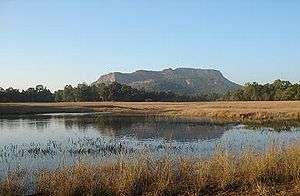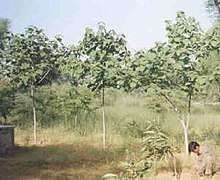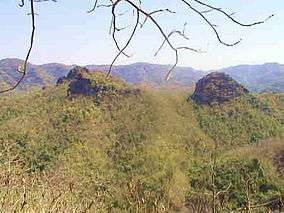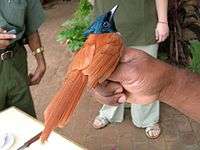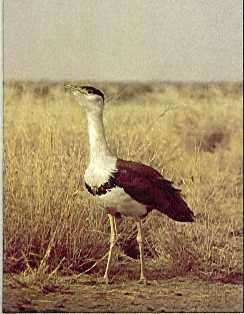Flora and fauna of Madhya Pradesh
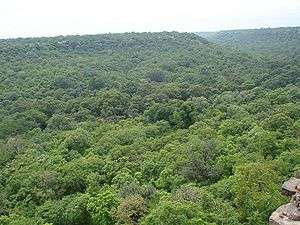
Madhya Pradesh is often called the Heart of India, is a state in central India. Its capital is Bhopal. Madhya Pradesh was originally the largest state in India until November 1, 2000 when the state of Chhattisgarh was carved out. It borders the states Uttar Pradesh, Chhattisgarh, Maharashtra, Gujarat and Rajasthan.
Forest statistics
Lying between latitude 21°04'N-26.87°N and longitude 74°02'-82°49' E, it is a reservoir of biodiversity. The geographical area of the state is 308,252 km2 which constitutes 9.38% of the land area of the country. The forest area of the state is 95,221 km2 constituting 30.71% of the geographical area of the state and 12.44% of the forest area of the country. Legally this area has been classified into "Reserved Forest, Protected Forest and Unclassified Forest", which constitute 61.7%, 37.4% and 0.9% of the forest area respectively. Per capita forest area is 2,400 m2 as against the national average of 700 m2
As per the latest estimates of Forest Survey of India, published in the State of Forest Report (IFSR) 2011, the total forest cover of M.P. is 94,690 km2., which is 30.71% of the land area - dense forest constituting 13.57% and open forest 11.22%.
One third of the state is forested and offers an exciting panorama of wildlife. In the national parks of Kanha, Bandhavgarh, Shivpuri and many others, one has the rare opportunity to see the tiger, bison and a wide variety of deer and antelope in sylvan surroundings. There are ten national parks and twenty five wildlife sanctuaries.
Forest composition
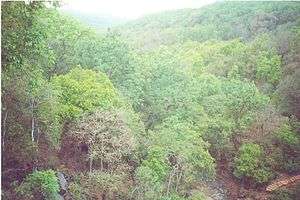
Central, eastern and southern parts of the state are rich, whereas northern and western parts are deficient in forest. Variability in climatic and edaphic conditions brings about significant difference in the forest types of the state. There are four important forest types: tropical moist, tropical dry, tropical thorn and subtropical broadleaved hill forests. The forest area can also be classified based on the composition of forest and terrain of the area. Based on composition, there are three important forest formations: teak forest, sal forest, and miscellaneous forest. Bamboo bearing areas are widely distributed in the state. To obviate pressure on the natural forests, plantations have been undertaken in forest and non forest areas to supplement the availability of fuel wood, small timber, fodder etc. Madhya Pradesh lost a good amount of forest recently when Chhattisgarh was carved out of it, as that region was the richest in forest.
Teak - Tectona grandis (common teak) is by far the most important timber species, with a wide distribution in Madhya Pradesh. It is found in following districts, namely Indore, Khandwa, Harda, Dewas, Sehore, Bhopal, Raisen, Vidisha, Betul, Hoshangaba, Chhindwara, Seoni, Balaghat, Mandla, Dindori, Shahdol, Umaria,Jabalpur, Damoh, Panna, Chhatarpur, Sagar, Satna, Rewa and Sidhi.
Sal - Sal or sakhu (Shorea robusta) is another important timber species in Madhya Pradesh. It is a large evergreen tree belonging to the family dipterocarpaceae. Sal forests of Madhya Pradesh are ecologically very important as they mark the termination of the great sal zone of the Central Indian Peninsula. Sal forests are located in the eastern part of the state while teak forests are localised in the western part. In between, there is a transition belt of mixed miscellaneous forests. There are also areas where teak and sal both species occur naturally mixed together forming unique ecosystem. Sal forests occupy an area of 7244 km2, which is about 7.6% of the total forest area of the state. The sal forests are confined to the eastern part of the state in the districts Rewa, Sidhi, Umaria, Anuppur and southwards in districts Balaghat, Mandla, Dindori, and Jabalpur and occupy all ranges of Maikal and the highlands of Balaghat. Sal forests are also distributed in and around Pachmarhi in Hoshangabad and Chhindwara districts.[1]
Mixed forests - The maximum forest cover in the state is that of mixed forests, which includes teak (Tectona grandis) or sal (Shorea robusta) mixed with other species like saja (Terminalia tomentosa), bija (Pterocarpus marsupium), lendia (Lagerstroemia parviflora), haldu (Haldina cordifolia), dhaora (Anogeissus latifolia), salai (Boswellia serrata), aonla (Emblica officinalis), amaltas (Cassia fistula), gamhar (Gmelina arborea), etc. Dazzling white kulu (Sterculia urens) trees scattered around stand out conspicuously among the various hues of green. The ground is covered with maze of grasses, plants, bushes and saplings.Pterocarpus marsupium is also used for control of blood sugar in Diabetes since ancient times in India.
Bamboo - Bamboo is also found at places in Madhya Pradesh forests. Normally Dendrocalamus strictus is the main bamboo species found overlapping with other species. It is distributed over Balaghat, Seoni, Chhindwara, Betul, Mandla and Shahdol districts.
Khair - Khair (Acacia catechu) trees are found in Jabalpur, Sagar, Damoh, Umaria, Hoshangabad, Guna, Shivpuri, Sheopur, Morena, Gwalior etc. Khair trees are used as a raw material for preparation of catechu or kattha.
NWFP - There are many important non-wood forest products (NWFP) found in the forests e.g. tendu leaves or bidi leaves (Diospyros melonoxylon), sal seed (Shorea robusta), chebulic myrobolan or harra (Terminalia chebula), gum, chironji (Buchanania lanzan), flower and seeds of mahua (Madhuca indica) and flowers, seeds, bark and roots of various plant species. Tendu leaves, sal seed and gums are nationalised forest produce in Madhya Pradesh whereas the other NWFP are non-nationalised. These non-nationalised NWFP can be collected and traded freely. The collection and trade of nationalised forest produce is regulated by the state.
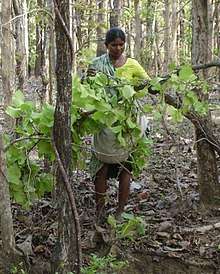
Medicinal plants - Medicinal trees and plants of various kinds are found in abundance in the forests of Madhya Pradesh. Important ones are: Aegle marmelos, Azadirachta indica, Bixa orellana, Butea monosperma, Asparagus racemosus, Argemone mexicana,Buchanania lanzan, Aloe barbadensis, Acorus calamus, Cassia tora, Curculigo orchioides, Curcuma longa, Embelia ribes, Clitoria ternatea, Mangifera indica, Cassia fistula, Evolvulus alsinoides, Commiphora mukul, Helicteres isora, Holorrhaena antidysenterica, Glycyrrhiza glabra, Woodfordia fruticosa,. Dioscorea spp, Plumbago zeylaniea, Terminalia bellirica, Tamarindus indica, Mucuna pruriens, Pongamia pinnata, Terminalia bellirica, Psoralea corylifolia, Phyllanthus embilica, Ocimum americanum, Rauvolfia serpentina, Tinospora cardifolio, Withania somnifera, Swertia chirayita, Tribulus terrestres, Chlorophytum tuberosum, Cyprus rotundus.
Forest growing stock
The total growing stock (volume of timber / wood) is 50,000,000 m3 valued worth Rs 2.5 lakh Crores.
Natural areas
Madhya Pradesh is home to 9 National Parks, including Bandhavgarh National Park, Kanha National Park, Satpura National Park, Sanjay National Park, Madhav National Park, Van Vihar National Park, Mandla Plant Fossils National Park, Panna National Park, and Pench National Park, Madhya Pradesh.
There are also a number of natural preserves, including Amarkantak, Patalkot, Bagh Caves, Bhedaghat, Bori Natural Reserve, Ken Gharial, Ghatigaon, Kuno Palpur, Narwar, Chambal, Kukdeshwar, Narsinghgarh, Nora Dehi, Pachmarhi, Panpatha, Shikarganj, and Tamia.
National Parks and their Fauna
There are 9 National Parks and 25 Sanctuaries spread over an area of 10,862 km2 constituting 11.40% of the total forest area and 3.52% of the geographical area of the state. Efforts are under way to increase the Protected Area network to 15% of the forest or 5% of the geographical.
There is a network of Protected Areas representative of bio-geographical zones. Special efforts have been made towards conservation of highly endangered species in the following National Parks and sanctuaries:
- Kanha, Bandhavgarh, Pench, Panna, and Satpura National Park are managed as project tiger areas.
- Sardarpur sanctuary in Dhar and Sailana are managed for conservation of kharmor or lesser florican.
- Ghatigaon sanctuary is managed for great Indian bustard or Son Chiriya.
- National Chambal Sanctuary is managed for conservation of gharial and crocodile, river dolphin, smooth-coated otter and a number of turtle species.
- Ken-gharial and Son-gharial sanctuaries are managed for conservation of gharial and mugger.
- Barasingha is the state animal and dudhraj is the state bird of Madhya Pradesh.
However,once upon a time Satpura region, now famous for numerous tiger reserves,was ruled by wild Indian elephant and lions.[2]
List of sanctuaries
There are 25 Wildlife sanctuaries in Madhya Pradesh. They are the following:[3]
- Bori Wildlife Sanctuary (Hoshangabad) 518.00 km2 (200.00 sq mi)
- Bagdara Sanctuary (Sidhi) 478.90 km2 (184.90 sq mi)
- Phen Sanctuary (Mandla) 110.74 km2 (42.76 sq mi)
- Ghatigaon Sanctuary (Gwalior) 512.00 km2 (197.68 sq mi)
- Gandhi Sagar Sanctuary (Mandsaur) 368.62 km2 (142.32 sq mi)
- Karera Sanctuary (Shivpuri) 202.21 km2 (78.07 sq mi)
- Ken Ghariyal Sanctuary (Chhatarpur, Panna) 45.00 km2 (17.37 sq mi)
- Kheoni Sanctuary (Dewas, Sehore) 122.70 km2 (47.37 sq mi)
- Narsingharh Sanctuary (Rajgarh) 57.19 km2 (22.08 sq mi)
- National Chambal Sanctuary (Morena) 320.00 km2 (123.55 sq mi)
- Nauradehi Wildlife Sanctuary (Sagar) 1,194.67 km2 (461.26 sq mi)
- Pachmarhi Sanctuary (Hoshangabad) 461.85 km2 (178.32 sq mi)
- Panpatha Sanctuary (Shahdol) 245.84 km2 (94.92 sq mi)
- Kuno Wildlife Sanctuary (Morena) 345.00 km2 (133.21 sq mi)
- Pench National Park (Seoni, Chhindwara) 449.39 km2 (173.51 sq mi)
- Ratapani Sanctuary (Raisen) 823.84 km2 (318.09 sq mi)
- Sanjay-Dubri Wildlife Sanctuary (Sidhi) 364.69 km2 (140.81 sq mi)
- Singhori Sanctuary (Raisen) 287.91 km2 (111.16 sq mi)
- Son Ghariyal Sanctuary (Sidhi) 41.80 km2 (16.14 sq mi)
- Sardarpur Sanctuary (Dhar) 348.12 km2 (134.41 sq mi)
- Sailana Sanctuary (Ratlam) 12.96 km2 (5.00 sq mi)
- Ralamandal wildlife Sanctuary (Indore) 5 km2 (1.9 sq mi)
- Orchha Sanctuary (Tikamgarh) 46 km2 (18 sq mi)
- Gangau Sanctuary, (Panna and Chhatarpur) 69 km2 (27 sq mi)
- Veerangna Durgawati Sanctuary (Damoh)24 km2 (9.3 sq mi)
Climate
Madhya Pradesh has a subtropical climate. Like most of north India, it has a hot dry summer(April–June) followed by monsoon rains (July–September) and a cool and relatively dry winter. The average rainfall is about 1,370 mm (53.9 in). It decreases from east to west. The south-eastern districts have the heaviest rainfall, some places receiving as much as 2,150 mm (84.6 in), while the western and north-western districts receive 1,000 mm (39.4 in) or less.
The Tribals and Forests
The tribal population is an integral part of the biodiversity of the forests since ages. A large number of ethnic aboriginal tribes are there who live in and around forests in Madhya Pradesh. The main tribal groups are:
See also
Gallery
References
- ↑ A.P. Dwivedi: Sal Borer Calamity, a case of M.P. and Chhatisgarh, Sai Publication Bhopal, 2005. p.7
- ↑ "Archived copy". Archived from the original on 2013-08-11. Retrieved 2013-08-11.
- ↑ "Wild Life". mpforest.org. Madhya Pradesh Forest Department. Retrieved 14 September 2016.
- Madhya Pradesh Forest Department
- Minor Forest Produce Federation Madhya Pradesh
- Madhya Pradesh A to Z, Madhya Pradesh State Tourism Development Corporation, Cross Section Publications Pvt. Ltd., New Delhi 1994
